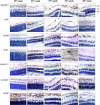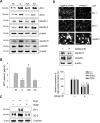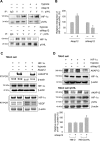AKAP12 regulates human blood-retinal barrier formation by downregulation of hypoxia-inducible factor-1alpha
- PMID: 17442832
- PMCID: PMC6672308
- DOI: 10.1523/JNEUROSCI.5368-06.2007
AKAP12 regulates human blood-retinal barrier formation by downregulation of hypoxia-inducible factor-1alpha
Abstract
Many diseases of the eye such as retinoblastoma, diabetic retinopathy, and retinopathy of prematurity are associated with blood-retinal barrier (BRB) dysfunction. Identifying the factors that contribute to BRB formation during human eye development and maintenance could provide insights into such diseases. Here we show that A-kinase anchor protein 12 (AKAP12) induces BRB formation by increasing angiopoietin-1 and decreasing vascular endothelial growth factor (VEGF) levels in astrocytes. We reveal that AKAP12 downregulates the level of hypoxia-inducible factor-1alpha (HIF-1alpha) protein by enhancing the interaction of HIF-1alpha with pVHL (von Hippel-Lindau tumor suppressor protein) and PHD2 (prolyl hydroxylase 2). Conditioned media from AKAP12-overexpressing astrocytes induced barriergenesis by upregulating the expression of tight junction proteins in human retina microvascular endothelial cells (HRMECs). Compared with the retina during BRB maturation, AKAP12 expression in retinoblastoma patient tissue was markedly reduced whereas that of VEGF was increased. These findings suggest that AKAP12 may induce BRB formation through antiangiogenesis and barriergenesis in the developing human eye and that defects in this mechanism can lead to a loss of tight junction proteins and contribute to the development of retinal pathologies such as retinoblastoma.
Figures










Similar articles
-
PHD2 attenuates high-glucose-induced blood retinal barrier breakdown in human retinal microvascular endothelial cells by regulating the Hif-1α/VEGF pathway.Inflamm Res. 2022 Jan;71(1):69-79. doi: 10.1007/s00011-021-01518-2. Epub 2021 Nov 13. Inflamm Res. 2022. PMID: 34773469
-
AKAP12 in astrocytes induces barrier functions in human endothelial cells through protein kinase Czeta.FEBS J. 2008 May;275(9):2338-53. doi: 10.1111/j.1742-4658.2008.06387.x. Epub 2008 Apr 3. FEBS J. 2008. PMID: 18397319
-
Acute intensive insulin therapy exacerbates diabetic blood-retinal barrier breakdown via hypoxia-inducible factor-1alpha and VEGF.J Clin Invest. 2002 Mar;109(6):805-15. doi: 10.1172/JCI13776. J Clin Invest. 2002. PMID: 11901189 Free PMC article.
-
Oxygen-dependent diseases in the retina: role of hypoxia-inducible factors.Exp Eye Res. 2006 Sep;83(3):473-83. doi: 10.1016/j.exer.2006.01.016. Epub 2006 Jun 5. Exp Eye Res. 2006. PMID: 16750526 Review.
-
Blood-retinal barrier.Eur J Ophthalmol. 2011;21 Suppl 6:S3-9. doi: 10.5301/EJO.2010.6049. Eur J Ophthalmol. 2011. PMID: 23264323 Review.
Cited by
-
Heme oxygenase metabolites improve astrocytic mitochondrial function via a Ca2+-dependent HIF-1α/ERRα circuit.PLoS One. 2018 Aug 28;13(8):e0202039. doi: 10.1371/journal.pone.0202039. eCollection 2018. PLoS One. 2018. PMID: 30153269 Free PMC article.
-
AKAP12 mediates barrier functions of fibrotic scars during CNS repair.PLoS One. 2014 Apr 23;9(4):e94695. doi: 10.1371/journal.pone.0094695. eCollection 2014. PLoS One. 2014. PMID: 24760034 Free PMC article.
-
PKA compartmentalization via AKAP220 and AKAP12 contributes to endothelial barrier regulation.PLoS One. 2014 Sep 4;9(9):e106733. doi: 10.1371/journal.pone.0106733. eCollection 2014. PLoS One. 2014. PMID: 25188285 Free PMC article.
-
Hypoxia Pathway Proteins and Their Impact on the Blood Vasculature.Int J Mol Sci. 2021 Aug 25;22(17):9191. doi: 10.3390/ijms22179191. Int J Mol Sci. 2021. PMID: 34502102 Free PMC article. Review.
-
The supplementation of a high dose of fish oil during pregnancy and lactation led to an elevation in Mfsd2a expression without any changes in docosahexaenoic acid levels in the retina of healthy 2-month-old mouse offspring.Front Nutr. 2024 Jan 24;10:1330414. doi: 10.3389/fnut.2023.1330414. eCollection 2023. Front Nutr. 2024. PMID: 38328686 Free PMC article.
References
-
- Abbott NJ, Ronnback L, Hansson E. Astrocyte-endothelial interactions at the blood-brain barrier. Nat Rev Neurosci. 2006;7:41–53. - PubMed
-
- Appelhoff RJ, Tian YM, Raval RR, Turley H, Harris AL, Pugh CW, Ratcliffe PJ, Gleadle JM. Differential function of the prolyl hydroxylases PHD1, PHD2, and PHD3 in the regulation of hypoxia-inducible factor. J Biol Chem. 2004;279:38458–38465. - PubMed
-
- Brown RC, Davis TP. Hypoxia/aglycemia alters expression of occludin and actin in brain endothelial cells. Biochem Biophys Res Commun. 2005;327:1114–1123. - PubMed
-
- Brown RC, Mark KS, Egleton RD, Davis TP. Protection against hypoxia-induced blood-brain barrier disruption: changes in intracellular calcium. Am J Physiol Cell Physiol. 2004;286:C1045–1052. - PubMed
Publication types
MeSH terms
Substances
LinkOut - more resources
Full Text Sources
Miscellaneous
